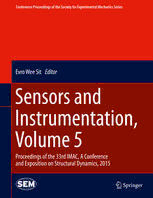
Sensors and Instrumentation, Volume 5: Proceedings of the 33rd IMAC, A Conference and Exposition on Structural Dynamics, 2015 PDF
Preview Sensors and Instrumentation, Volume 5: Proceedings of the 33rd IMAC, A Conference and Exposition on Structural Dynamics, 2015
Conference Proceedings of the Society for Experimental Mechanics Series Evro Wee Sit Editor Sensors and Instrumentation, Volume 5 Proceedings of the 33rd IMAC, A Conference and Exposition on Structural Dynamics, 2015 Conference Proceedings of the Society for Experimental Mechanics Series SeriesEditor TomProulx SocietyforExperimentalMechanics,Inc. Bethel,CT,USA Moreinformationaboutthisseriesathttp://www.springer.com/series/8922 Evro Wee Sit Editor Sensors and Instrumentation, Volume 5 Proceedings of the 33rd IMAC, A Conference and Exposition on Structural Dynamics, 2015 123 Editor EvroWeeSit SVcommunity.com HermosaBeach,CA,USA ISSN2191-5644 ISSN2191-5652 (electronic) ConferenceProceedingsoftheSocietyforExperimentalMechanicsSeries ISBN978-3-319-15211-0 ISBN978-3-319-15212-7 (eBook) DOI10.1007/978-3-319-15212-7 LibraryofCongressControlNumber:2015937182 SpringerChamHeidelbergNewYorkDordrechtLondon ©TheSocietyforExperimentalMechanics,Inc.2015 Thisworkissubjecttocopyright.AllrightsarereservedbythePublisher,whetherthewholeorpartofthematerialisconcerned,specificallytherights oftranslation,reprinting,reuseofillustrations,recitation,broadcasting,reproductiononmicrofilmsorinanyotherphysicalway,andtransmissionor informationstorageandretrieval,electronicadaptation,computersoftware,orbysimilarordissimilarmethodologynowknownorhereafterdeveloped. Theuseofgeneraldescriptivenames,registerednames,trademarks,servicemarks,etc.inthispublicationdoesnotimply,evenintheabsenceofaspecific statement,thatsuchnamesareexemptfromtherelevantprotectivelawsandregulationsandthereforefreeforgeneraluse. Thepublisher,theauthorsandtheeditorsaresafetoassumethattheadviceandinformationinthisbookarebelievedtobetrueandaccurateatthedateof publication.Neitherthepublishernortheauthorsortheeditorsgiveawarranty,expressorimplied,withrespecttothematerialcontainedhereinorforany errorsoromissionsthatmayhavebeenmade. Printedonacid-freepaper SpringerInternationalPublishingAGSwitzerlandispartofSpringerScience+BusinessMedia(www.springer.com) Preface SensorsandInstrumentationrepresentsoneoftenvolumesoftechnicalpaperspresentedatthe33rdIMAC,AConference andExpositiononStructuralDynamics,2015,organizedbytheSocietyforExperimentalMechanics,andheldinOrlando, Florida February 2–5, 2015. The full proceedings also include volumes on Nonlinear Dynamics; Dynamics of Civil Structures;ModelValidationandUncertaintyQuantification;DynamicsofCoupledStructures;SpecialTopicsinStructural Dynamics; Structural Health Monitoring and Damage Detection; Experimental Techniques, Rotating Machinery and Acoustics;andShockandVibrationAircraft/Aerospace,EnergyHarvesting;andTopicsinModalAnalysis. Eachcollectionpresentsearlyfindingsfromexperimentalandcomputationalinvestigationsonanimportantareawithin Sensors and Instrumentation. Topics represent papers on calibration, smart sensors, rotational effects, stress sensing and trackingofdynamics.Topicsinthisvolumeinclude: ExperimentalTechniques SmartSensing RotationalEffects DynamicCalibration Theorganizerswouldliketothanktheauthors,presenters,sessionorganizers,andsessionchairsfortheirparticipationin thistrack. HermosaBeach,CA,USA EvroWeeSit v Contents 1 LLCDExperimentalLine-of-SightJitterTesting..................................................................... 1 BrandonJ.Dilworth 2 AVirtualRealityGloveboxwithDynamicSafetyModelingforImprovedCriticality RegulationVisualization................................................................................................. 11 KyleEmbry,AndreaHengartner-Cuellar,HannahRoss,andDavidMascareñas 3 PracticalCalibrationTechniquesfortheModalImpactHammer.................................................. 23 TongWang,OzanCelik,F.NecatiCatbas,andLingmiZhang 4 FrequencyTuningofaWineglassResonatorBasedonAcousticTesting .......................................... 31 HuinamRhee,SangjinPark,SergiiA.Sarapuloff,SoonWooHan,andJinHoPark 5 AnInnovativeTribometerforMeasurementsBetween SportFabricsandIce .................................................................................................... 37 E.Belloni,D.Milani,andF.Braghin 6 PassiveStressSensingUsingRamanPiezo-Spectroscopy............................................................ 45 N.-G.Kim,T.McCulloch,J.-J.Lee,andH.-B.Yun 7 SmartSensors:AStudyofPowerConsumptionandReliability.................................................... 53 JamesLong,JeffreyK.Swidrak,MichaelY.Feng,andOralBuyukozturk 8 AModel-BasedApproachfortheDynamicCalibrationofTorqueTransducers.................................. 61 LeonardKlaus,MichaelKobusch,andThomasBruns 9 SmartTyreInducedBenefitsinSideslipAngleandFrictionCoefficientEstimation............................. 73 F.Cheli,D.Ivone,andE.Sabbioni 10 RotationalAccelerometersandTheirUsageinInvestigatingShakerHeadRotations ........................... 85 M.DumontandN.Kinsley vii Chapter 1 LLCD Experimental Line-of-Sight Jitter Testing BrandonJ.Dilworth Abstract The LLCD program at MIT Lincoln Laboratory is the first space laser communication system for NASA. The optical communications terminal was carried into lunar orbit by the LADEE spacecraft which launched on September 6, 2013. The primary goal of the LLCD program is to demonstrate optical communication from lunar orbit to the Earth’s surface. OpticalcommunicationsystemshavemanyadvantagesoverRFsystemswhichincludeachievinghigherdataratesusing lower size, weight and power (SWaP). Optical communication systems rely on much narrower beams than RF systems to achievetheseadvantages;thepenaltyisthattheopticalbeammusthavegoodstabilityinordertomaintainthecommunication linkbetweenthetransmitterandreceiver.Thereareanumberoffactorsthatplayaroleinthestabilityoftheopticalbeam, butthefocusofthistalkisontheresidualLOSjitterresultingfromunrejectedspacecraftexcitation.Experimentationwith physicalhardwareisacommonmethodforvalidatingmathematicalmodels,includingresidualLOSjittermodels.TheLLCD programdevelopedatestbenchinordertovalidatetheresidualLOSjittermodelwhichprovideshigherconfidenceinthe computationalresults. Keywords LOSjitter • Opticalcommunication • Modelvalidation • MIMOsinetesting • LLCD Nomenclature DOF DegreeofFreedom FEM FiniteElementModel ICD InterfaceControlDocument IR Infrared LADEE LunarAtmosphereandDustEnvironmentExplorer LLCD LunarLaserCommunicationDemonstration LOS Line-of-Sight MAC ModalAssuranceCriterion MIMO MultipleInputMultipleOutput MIRU Magneto-hydrodynamicInertialReferenceUnit MIT MassachusettsInstituteofTechnology NASA NationalAeronauticsandSpaceAdministration PSD PowerSpectralDensity RF RadioFrequency SNR Signal-to-NoiseRatio Statement This work is sponsored by the National Aeronautics and Space Administration under Air Force Contract #FA8721-05-C-0002. Opinions, interpretations,conclusionsandrecommendationsarethoseoftheauthorandarenotnecessarilyendorsedbytheUnitedStatesGovernment. B.J.Dilworth,Ph.D.((cid:2)) MITLincolnLaboratory,244WoodStreet,Lexington,MA02420,USA e-mail:[email protected] ©TheSocietyforExperimentalMechanics,Inc.2015 1 E.W.Sit(ed.),SensorsandInstrumentation,Volume5,ConferenceProceedingsoftheSociety forExperimentalMechanicsSeries,DOI10.1007/978-3-319-15212-7_1 2 B.J.Dilworth 1.1 Introduction TheLLCDprogramdevelopedandfieldedthefirstduplexlasercommunicationsystemforNASA.MITLincolnLaboratory designedandbuiltaspaceterminalforlunarorbitandtheprimarygroundterminaltoexecutethedemonstration.Amonth afterlaunch,theLLCDsystemdemonstrateda20Mbpsuplinkanda622MbpsdownlinkbetweentheMoonandtheEarth. Both links represent data rates much higher than ever achieved previously over that distance. An overview of the system architectureanddemonstrationresultshavebeenpreviouslypublished[1]. Opticalcommunicationsystemsusemuchshorter(>10,000(cid:2))wavelengthsascomparedtoexistingRFcommunication systems. The shorter wavelengths enable large bandwidth modulation, higher data rates and low diffraction losses as comparedtoRFsystems.Theshorterwavelengthresultsinanarrowbeamwidthwhichmeansthattheopticalterminals(at bothendsofthelink)canbemuchsmallerandrequirelesspowerthantheirRFcounterparts.However,anarrowbeamwidth meansbeamstabilitybecomesamuchmoresignificantchallenge.FortheLLCDspaceterminal,theresultingrequirement wasthatthebeamhadtobestabilizedbetterthan4.2(cid:2)radtomaintainthecommunicationlink. The space terminal optical module included several features in order to achieve the pointing requirements which are graphically summarized in Fig. 1.1. Initial pointing of the terminal is executed by the spacecraft with accuracy based on theperformanceofitsstartrackers.The2-axisgimbalprovidescoarsepointingwhiletheMIRUprovidesthefinepointing and inertial stabilization of the optical head. The telescope is an all-beryllium structure with a 10 cm primary mirror. The approachofthecontrolsystemandthearchitectureoftheopticalpathshavebeendescribedpreviously[2]. 1.2 Line-of-SightJitter Line-of-sightjitterissimplydefinedasthetime-varyingmotionoftheimageonthedetectorplane[3].Inimagingsystems (likecameras),LOSjittercanresultinblurredimages.Inlasercommunicationsystems,LOSjittercanresultinlossofdata rate.Inbothscenarios,theLOSjittercanbeinducedeitherinternallyfromorexternallytothesystem.Typicalsourcesof self-excitation are due to the tracking system mechanism(s). On the LLCD Space Terminal, the dominant sources of self- excitationwereduetotheGimbalmotion(steppermotors)andthenutationmechanismontheOpticalHead.Primarysources of external excitation were due to the reaction wheels on the LADEE spacecraft coupling through the spacecraft structure andactingasbaseexcitationtotheInstrumentPanel.Theexternalexcitationwasprescribedearlyintheprogrambasedon Fig.1.1 LLCDspaceterminal opticalmodule
